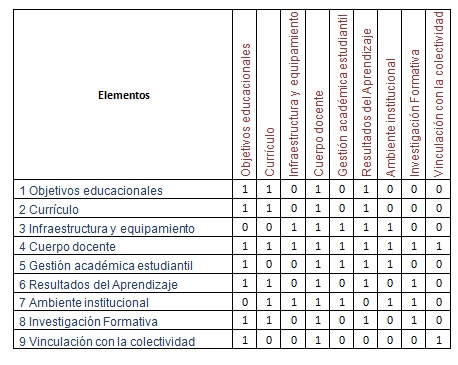-
Paper Information
- Paper Submission
-
Journal Information
- About This Journal
- Editorial Board
- Current Issue
- Archive
- Author Guidelines
- Contact Us
American Journal of Systems Science
2015; 4(2): 27-35
doi:10.5923/j.ajss.20150402.01

Model of University Management, Quality Assurance
Gina S. Mejía 1, Kléber H. Mejía 2
1Central University of Ecuador, Faculty of Economics
2National Polytechnic School, Faculty of Management
Correspondence to: Gina S. Mejía , Central University of Ecuador, Faculty of Economics.
| Email: |  |
Copyright © 2015 Scientific & Academic Publishing. All Rights Reserved.
This work is licensed under the Creative Commons Attribution International License (CC BY).
http://creativecommons.org/licenses/by/4.0/

This article describes how to design a management model that enables the accreditation and quality assurance of the School of Engineering and Business, College of Administrative Sciences of the National Polytechnic School of Ecuador. These criteria are: i) educational objectives, ii) curriculum, iii) infrastructure and equipment, iv) faculty, v) student academic management, vi) learning outcomes or achievements, vii) student environment, viii) formative research, ix) links with the community. In this sense, the change is also in the integration of four new criteria that are considered primary as mentioned in the Higher Education Act-LOES-its General Regulation and the Law of Transparency and Access to Public Information,-LOTAIP, and other regulations. It includes a criterion that is related to the criterion number 4-Accreditation Board for Engineering and Technology. In conclusion, the model presented is composed of 13 criteria, which allowed us to evaluate the quality of the Business Engineering program. It is estimated that the results achieved can become the baseline, for, on the one hand, create an action plan to improve quality of education in the Engineering Company of the National Polytechnic School.
Keywords: Accreditation, Quality assurance, Management model, Evaluation, Self-Assessment, Assessment
Cite this paper: Gina S. Mejía , Kléber H. Mejía , Model of University Management, Quality Assurance, American Journal of Systems Science, Vol. 4 No. 2, 2015, pp. 27-35. doi: 10.5923/j.ajss.20150402.01.
Article Outline
1. Introduction
- The Constituent Resolution No. 14 issued by the National Constituent Assembly on July 22, 2008, mandates the National Assessment and Accreditation -CONEA- to prepare a technical report on the level of institutional performance of institutions of higher education in order to ensure their quality, promoting their clearance and improvement.Art. 96 of the same Act states that "The Quality Assurance in Higher Education, consists of the set of actions carried out by the institutions involved in this sector, in order to ensure the efficient and effective management, applicable to careers, academic programs, institutions of higher education and also to the councils or evaluators and accreditation bodies ".According to the Regulation of the Organic Law on Higher Education, issued in the Official Register No. 526, Article 9 states: "In quality.- Assessment The quality assessment will be made periodically in accordance with regulations issued by the Board of Evaluation, Accreditation and Quality Assurance of Higher Education, CEAACES. (General Regulation of the Organic Law on Higher Education, 2011). Below in Figure 1 the accreditation scheme follows:
 | Figure 1. Article 173 of the LOES (Figure prepared by the researcher |
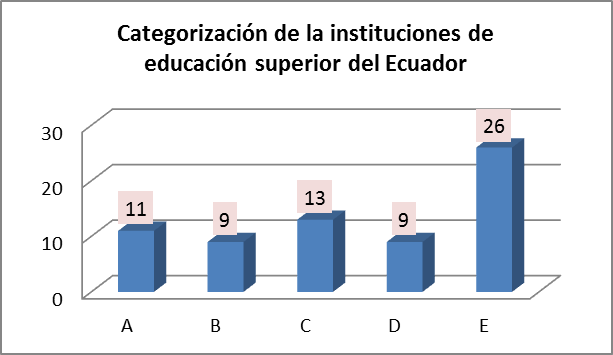 | Figure 2. Categories of Universities and Polytechnics (Mandate No. 14, 04-11-2009, p. 2-11) |
2. Literature Review
- The Constitution of the Republic of Ecuador, 2008 in the first section, Education states: "Art. 343. The national education system shall be aimed at developing individual and collective capacities and potentials of the population, that enable learning, and the generation and use of knowledge, skills, knowledge, arts and culture. The system will be centered to learner, and work in a flexible and dynamic, inclusive, effective and efficient. The national education system will integrate intercultural vision commensurate with geographic, cultural and linguistic diversity of the country, and respect for the rights of communities, peoples and nationalities.For its part, the National Development Plan for Good Living 2009-2013, features 12 strategies with key variables that contribute to national development. Precisely in the fifth strategy, "Transforming higher education and knowledge transfer through science, technology and innovation," mentioned "... it is essential to ensure the quality, sustain maximum objectivity, impartiality and the highest standards to evaluate and accredit institutions of higher education, their programs and careers .... " (SENPLADES, 2012).According to Article 94 of the Law on Higher Education, -LOES the Board of Evaluation, Accreditation and Quality Assurance in Higher Education -., Second paragraph states that the "Quality Assessment is a process to determine the conditions the institution or academic program run by the systemic collection of quantitative and qualitative data to make a judgment or diagnosis, analysing its components, functions, processes so that its results serve to reform and improve the curriculum.” In addition, the "Quality Assessment is an ongoing process and involves continuous monitoring." (Organic Law on Higher Education, 2010).Article 96 of the same Act states that: "The Quality Assurance in Higher Education consists of the set of actions carried out by the institutions involved in this sector, in order to ensure the efficient and effective management, applicable to careers, academic programs, institutions of higher education and also to the councils or evaluators and accreditation bodies ". (Organic Law on Higher Education, 2010).Furthermore, in Article 355 of the Supreme Charter, among other principles, it states: "The State recognizes the universities and polytechnics autonomy academic, administrative, financial and organizational, in line with the development objectives of the regime and the principles set in the constitution. Universities and polytechnics are granted the right to autonomy, exercised and understood solidarity and responsible manner. Such autonomy guarantees the exercise of academic freedom and the right to search for truth, without restrictions; the governance and management of themselves, consistent with the principles of alternation, transparency and political rights; and the production of science, technology, culture and art. Autonomy does not relieve the institutions of the system to be controlled, social responsibility, accountability and participation in national planning. "In Article 17 LOES, it has the "Recognition of autonomy responsible. - The State recognizes the universities and polytechnics autonomy academic, administrative, financial and organizational, in accordance with the principles established in the Constitution of the Republic. In the exercise of responsible autonomy, universities and polytechnics will maintain relations of reciprocity and cooperation among them and with the State and society; observe the principles of justice, equity, solidarity, citizen participation, social responsibility and accountability. “(Organic Law on Higher Education, 2010).On the one hand, Art. 25 of the same Act, talks about the "Accountability System accounts.- Institutions of Higher Education will be held accountable for meeting its purposes and public funds received through the mechanism established by the Comptroller General, in coordination with the Ministry of Higher Education, Science, Technology and Innovation, and pursuant to the provisions of the law governing access to information ". (Organic Law on Higher Education, 2010).Also, in the LOES, in Art. 27. "Accountability accounts.- social institutions that are part of the System of Higher Education, in the exercise of his responsible autonomy, have annual accountability to society, on the fulfilment of its mission, goals and objectives. What accountability is also made to the Council of Higher Education; and, in Article 50, of the same Code stipulates that one of the duties of the rector is “submit an annual report of accountability to society, university or polytechnic community, the Council of Higher Education"; and the Ministry of Higher Education, Science, Technology and Innovation, which will be published in a way that ensures their widespread dissemination. “(Organic Law on Higher Education, 2010).Fulfilling what the Art 25 of the LOES about the "... law governing access to information", this law is the Organic Law of Transparency and Access to Public Information -LOTAIP-, published on May 14, 2004 . (LOTAIP, 2004).Article 7 of the LOTAIP refers to the dissemination of public information: "For transparency in the administration who are required to observe all the state institutions that make up the public sector in terms of Article 118 of the Constitution the Republic and other entities mentioned in Article 1of this Law, disseminated through an information portal or website, and the means available to the public, implemented at the same institution, the following minimum information updated, which for purposes of this Act it is considered binding in nature:a) Functional organizational structure, legal framework that governs regulations and procedures applicable to the entity; the goals and objectives of administrative units under their operational programs;b) The complete directory of the institution and its distributive personnel;c) The monthly remuneration and any additional income since, including the system of compensation as provided for by the relevant provisions;d) The services offered and how to access them, opening hours and further information necessary to enable citizens to exercise their rights and fulfill their obligations;e) Full text of all collective agreements in force in the institution and its annexes and amendments;f) the application forms or formats that are required for the procedures inherent to its scope be published;g) Full information on the annual budget which administers the institution, specifying income, expenses, financing and operating results in accordance with budget classifiers and budget settlement, specifying recipients of the delivery of public resources;h) The results of internal audits and government budget year;i) complete and detailed information on the pre-contract processes, contract, award and settlement of contracts for works, procurement of goods, services, commercial leases, etc., held by the institution with natural or legal persons, including concessions, permits or authorizations;j) A list of companies and individuals who have violated contracts with that institution;k) Plans and programs running of the institution;l) Details of contracts external or internal credit;m) Mechanisms of accountability to the public, such as goals and management reports and performance indicators;n) The per diem, working papers and supporting national or international mobilization of authorities, dignitaries and public officials;o) The name, office address, zip code and e-mail addressResponsible for addressing the public information of this Law;s) The sectional bodies timely inform the public of the resolutions they adopt, by publishing the minutes of the respective meetings of these collegial bodies and their plans local development; and the information should be published, organizing by subject, items, sequential or chronological order, etc., without grouping or generalize, so that citizens can be informed correctly and without confusion ". (LOTAIP, 2004).Article 8 of the same Act provides for the "Promotion of the Right of Access to Information.- All entities in the public sector under the terms of Article 118 of the Constitution of the Republic and other entities mentioned in Article 1 of this Law shall be implemented according to their skills and budgetary resources, outreach programs and targeted training to both public servants and the organizations of civil society, in order to ensure more and better citizen participation in the life of Been". (LOTAIP, 2004)."Universities and other institutions of education system programs develop awareness activities, dissemination and promotion of these rights. (LOTAIP, 2004).
3. Management Models
- Management models allow optimizing the execution of processes in order to increase quality and efficiency in administration of services. When management model is indicated, it is commonly associated with -PHVA-, Plan-Do-Check-Act cycle. In the present study, the implementation of the management model will help achieve accreditation and quality assurance of Enterprise Engineering career.From a systemic approach, the components of the model are: inputs, outputs, inputs and resources that are characteristic of continuous improvement.The "Working Paper (28-02-2011)" containing the Model for the Assessment of the Engineering Accreditation purposes, issued by the CEAACES, seeks to ensure the quality and continuous improvement of the race. It is structured by: Educational Objectives, Curriculum, Infrastructure and Equipment, Faculty, Student Academic Management, Institutional Environment, formative research and links with the community. It consists of nine criteria, which will be explained later; they are detailed in percentages and are made up of 18 sub-criteria, 84 indicators and more than 84 sources of reference verification. In Figure 3, a graphical representation and indicated sequence:
 | Figure 3. Ranking criteria (General Model Racing, CEAACES, 03-03-2011, p. 42) |
4. Accreditation Processes and Systems Theory
- Article 95 of the LOES states: "Accreditation is the product of a rigorous assessment of compliance with guidelines, standards and quality criteria worldwide, careers, programs, postgraduate and institutions, compulsory and independent, It will define the Council of Evaluation, Accreditation and Quality Assurance in Higher Education ". (Organic Law on Higher Education, 2010). As previously noted, this procedure includes a self-assessment of the institution itself, as well as an external evaluation by a team of peer experts, who in turn must be credited periodically.Additionally, the book "Invitation to the General Systems Theory" states that "... using systems theory can be built more or less sophisticated descriptions including relations between the variables increase the degree of accuracy of the description with reality"; this statement the rector of the Institute of Petroleum Public Company Petro Ecuador, Dr. Arturo Romero adds: "... and goes further, arguing that uncertainty cannot be eliminated, the level of rest that is generated cannot be eliminated and with which we have to live, looking for that balance if the states that correspond to each subsystem and overall system because it not be administered would be impossible to avoid the crisis. " (Saenz, 2009).In addition, Dr. Sáenz noted that to define a system must follow these steps:1) Identify elements of the system.2) Identify the attributes and properties of the elements.3) Identify emerging attributes and properties (properties acquired by the system structure and system elements).4) Identify and characterize the relationships between elements by means of a matrix, if an item is related to another number 1 is set, otherwise the number 0. Subsequently, a graph associated with the matrix is constructed and studied flows graph: information, action decision.
5. Definition of Management Model
- With this background the management model to be determined, is the result of the analysis of different sources of information such as legal regulations (laws, regulations, amendments, resolutions, technical standards), books, articles and papers. It will also consider technical elements as criteria, sub-criteria and indicators in Ecuador in institutions such as the Council for Higher Education, CEAACES and those from Ibero-American and English countries like ABET. As previously indicated, the management model proposed in the following pages, will be based on the principles of quality management: Based Management Systems, Process Approach and Continuous Improvement.Figure 4 presented below relates the 3 principles of quality management; and its relationship with the Deming cycle: PDCA, Plan-Do-Check-Act:
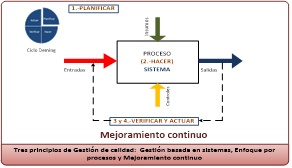 | Figure 4. Modified by the Investigating (Standards for accreditation of university accounting career, Coneau Peru) |
 has a position and has properties and attributes
has a position and has properties and attributes  Among the different elements of Ω is possible to establish relationships and functions
Among the different elements of Ω is possible to establish relationships and functions  La trick:
La trick:  is a system.Equation 1 - Definition of system(Saenz, 2009, p. 87)Dr. Saenz, also mentions that to define a system must take the following steps: 1. Identify the elements of the system; 2. Identify the attributes or properties of the elements; 3. Identify emerging attributes and properties (properties acquired by the system structure and system elements); and, 4. Identify and characterize the relationships between elements by means of a matrix, if an item is related to another can put on the array number 1, otherwise the number 0. Subsequently, an associated graph is constructed the matrix and graph flows are studied: information, action decision. " (Saenz, 2009).Following the methodology previously written to the definition of a system, first, the system elements will be identified, that is, each of the nine criteria set out in Working Paper (28-02-2011) containing the Model Assessment of the Engineering Accreditation purposes.Now system elements Xi (S) defined:X1 = Matrix Educational Objectives.X2 = Curriculum Matrix.X3 = Matrix infrastructure and equipment.Matrix X4 = Faculty.X5 = Student Academic Management MatrixX6 = Matrix Results or Accomplishments Learning.X7 = Matrix Institutional Environment.X8 = Matrix Formative Research.X9 = Matrix Engagement, Community.
is a system.Equation 1 - Definition of system(Saenz, 2009, p. 87)Dr. Saenz, also mentions that to define a system must take the following steps: 1. Identify the elements of the system; 2. Identify the attributes or properties of the elements; 3. Identify emerging attributes and properties (properties acquired by the system structure and system elements); and, 4. Identify and characterize the relationships between elements by means of a matrix, if an item is related to another can put on the array number 1, otherwise the number 0. Subsequently, an associated graph is constructed the matrix and graph flows are studied: information, action decision. " (Saenz, 2009).Following the methodology previously written to the definition of a system, first, the system elements will be identified, that is, each of the nine criteria set out in Working Paper (28-02-2011) containing the Model Assessment of the Engineering Accreditation purposes.Now system elements Xi (S) defined:X1 = Matrix Educational Objectives.X2 = Curriculum Matrix.X3 = Matrix infrastructure and equipment.Matrix X4 = Faculty.X5 = Student Academic Management MatrixX6 = Matrix Results or Accomplishments Learning.X7 = Matrix Institutional Environment.X8 = Matrix Formative Research.X9 = Matrix Engagement, Community. Equation 2 - X = Element SetSecond, the attributes or properties of the elements is identified, that is, the
Equation 2 - X = Element SetSecond, the attributes or properties of the elements is identified, that is, the  where A is the set of attributes, the system (S) is taken every sub 18 and 84 indicators in Working Paper (28-02-2011) containing the Model for the Assessment of the Engineering Accreditation purposes.Now we have the sets {X} and {A} corresponding respectively; one, to the system elements; and, the other, the attributes or properties of the elements.
where A is the set of attributes, the system (S) is taken every sub 18 and 84 indicators in Working Paper (28-02-2011) containing the Model for the Assessment of the Engineering Accreditation purposes.Now we have the sets {X} and {A} corresponding respectively; one, to the system elements; and, the other, the attributes or properties of the elements. Equation 3 - Definition of set: elements {X}Now define the elements with their properties or attributes:
Equation 3 - Definition of set: elements {X}Now define the elements with their properties or attributes: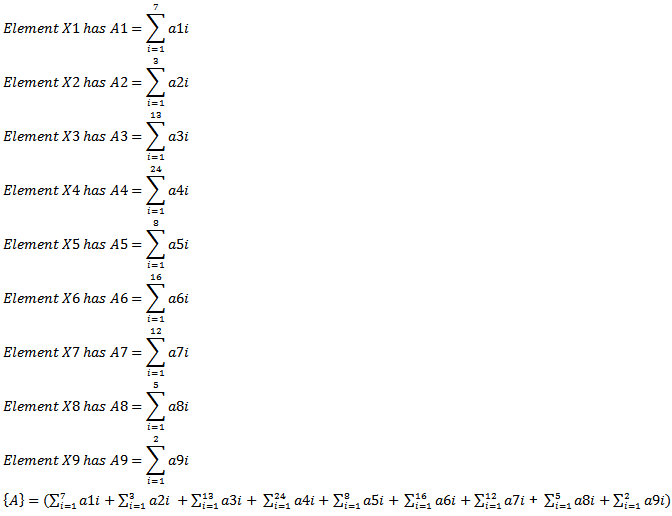 Equation 4 - Definition of set: {A} of elementsAdditionally, nine criteria are stated on page 24 of this investigation, it will include four criteria or elements; which research and legal regulations are necessary to include in the model because they are part of the LOES, Articles 17, 25, 27 and 124; and LOTAIP Article 7 and 8, as demonstrated in the theoretical framework on pages 30-32 of this investigation.These four criteria are: 1 criterion of transparency and access to public information (Article 7 of the -LOTAIP-), 1 accountability criteria (LOTAIP and Articles 25 and 27 of the LOES), 1 criteria of social responsibility and code ethics (Article 124 of the LOES); and 1 criterion of continuous improvement (Criteria for Accrediting ENGINEERING PROGRAMS, 2013-2014); total 13 criteria. Next, the 4 mentioned criteria:X10 = Matrix wing transparency and access public information.X11 = array accountability.X12 = Code of ethics and social responsibility. X13 = Continuous Improvement.Now the management system is formed by the X and A joint: elements 13 or criteria; and, the attributes or properties of each of the 13 criteria, which have:
Equation 4 - Definition of set: {A} of elementsAdditionally, nine criteria are stated on page 24 of this investigation, it will include four criteria or elements; which research and legal regulations are necessary to include in the model because they are part of the LOES, Articles 17, 25, 27 and 124; and LOTAIP Article 7 and 8, as demonstrated in the theoretical framework on pages 30-32 of this investigation.These four criteria are: 1 criterion of transparency and access to public information (Article 7 of the -LOTAIP-), 1 accountability criteria (LOTAIP and Articles 25 and 27 of the LOES), 1 criteria of social responsibility and code ethics (Article 124 of the LOES); and 1 criterion of continuous improvement (Criteria for Accrediting ENGINEERING PROGRAMS, 2013-2014); total 13 criteria. Next, the 4 mentioned criteria:X10 = Matrix wing transparency and access public information.X11 = array accountability.X12 = Code of ethics and social responsibility. X13 = Continuous Improvement.Now the management system is formed by the X and A joint: elements 13 or criteria; and, the attributes or properties of each of the 13 criteria, which have: As a third step is to identify the attributes and emergent properties, ie, properties acquired by the system when the elements are structured, when this condition occurs in the system is the evaluation model of engineering degrees purposes of accreditation.As a fourth step, identify and characterize the relationships between elements by means of a matrix, if an item is related to another is placed on the matrix number 1, otherwise the number 0.
As a third step is to identify the attributes and emergent properties, ie, properties acquired by the system when the elements are structured, when this condition occurs in the system is the evaluation model of engineering degrees purposes of accreditation.As a fourth step, identify and characterize the relationships between elements by means of a matrix, if an item is related to another is placed on the matrix number 1, otherwise the number 0.
|
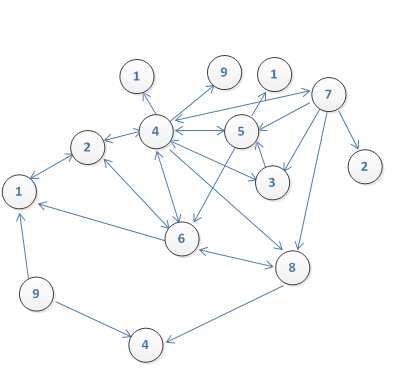 | Figure 5. Graph associated relationship matrix elements of the system |
 Next,
Next, 
 To have the complete system has joined the 9 criteria for the evaluation model for the accreditation of the races and the four criteria proposed by the researcher, with this addition, the model was ready to be applied and get the respective results.To obtain a result of the career of Engineering Company is to make the diagnosis in two parts. The first, corresponding to the nine criteria; and, second, the four additional criteria. Then you can make a weighting of less Z. That is, the first diagnosis was calculated as 100%; and, in the second diagnosis, a value of Z for the four criteria set. As described above, corresponds to a mathematical device, which in this case, have taken a Z = 10%, but being a model, the Z value may vary according to the needs assessment model, self-assessment and career.Then, if Z = 10%, we have:X10 Z = 4% + 4% + 1% X11 X12 X13 + 1%Equation 5 - Equation increase of four criteriaThe complete model is defined as:
To have the complete system has joined the 9 criteria for the evaluation model for the accreditation of the races and the four criteria proposed by the researcher, with this addition, the model was ready to be applied and get the respective results.To obtain a result of the career of Engineering Company is to make the diagnosis in two parts. The first, corresponding to the nine criteria; and, second, the four additional criteria. Then you can make a weighting of less Z. That is, the first diagnosis was calculated as 100%; and, in the second diagnosis, a value of Z for the four criteria set. As described above, corresponds to a mathematical device, which in this case, have taken a Z = 10%, but being a model, the Z value may vary according to the needs assessment model, self-assessment and career.Then, if Z = 10%, we have:X10 Z = 4% + 4% + 1% X11 X12 X13 + 1%Equation 5 - Equation increase of four criteriaThe complete model is defined as: Equation 6 - mathematical definition of the management model
Equation 6 - mathematical definition of the management model6. Collection of Information
- To gather information for the evaluation of an engineering degree, he had to collect and process information from different sources provided by each of the informants. This information was tabulated in the 13 matrices describing the 13 criteria or elements that make up the model. In addition, this information is obtained from the application of techniques and incorporated therein matrices instruments, promoting a broad meeting of all college players and other entities linked to analyze the current situation of the race Enterprise Engineering and thus have a clear vision on where you are and where you're going; for the latter purpose an action plan for improvement of the race will be established.Secondary data sources are the legal regulations of higher education, the National Polytechnic School, Faculty of Management, Enterprise Engineering career; additionally, in books, theses, websites and reports. Techniques and instruments for primary sources of data needed for this research such as observation, survey and interview will be used; the result of the implementation of these instruments will be incorporated into the matrices containing 13 elements or criteria for the definition of the management model for accreditation and quality assurance of Enterprise Engineering career.In addition, meetings were established: a teacher in the Engineering and director of this research project (Kléber Mejia); Mr. Wilson Abad, former Dean of the FCA.; Staff Unit Information Management (Ing Juan Carlos Proaño.); Commission staff Internal Evaluation (Michael Vizuete Ing.); Staff Curriculum Development Unit (Sandra Sanchez Ing.); Planning staff (Ing. Geovanina Salas).Definition of sample sizeTo set the size of the sample to apply the survey technique has been used, according to the (Galindo, 1999) author of the book "Statistics for Management and Engineering", the following formula:
 Mathematical Formula 1 - Sample Size As many times the estimate p level is unknown, making the maximum size of the sample, which is obtained by p = q = 0.5, where N = population size, sample size n, E = present mistake and Z of confidence.Additionally, you can see in Figure 15, the number of students in the last 13 years and in 2013 A, has a population of 251 students studying Business Engineering.Francisco Jaramillo (2009) states that: "... you can handle error margins up to 10% ..."; and that in defining the levels of trust or reliability, they "... indicate how likely the estimate made suits and must assume a higher value to adjust the actual value of the property evaluated in the population ..." ; then, we have chosen the first stage, with an error rate of 10% confidence level or higher reliability, i.e. 98%, which is going to take 88 student surveys.
Mathematical Formula 1 - Sample Size As many times the estimate p level is unknown, making the maximum size of the sample, which is obtained by p = q = 0.5, where N = population size, sample size n, E = present mistake and Z of confidence.Additionally, you can see in Figure 15, the number of students in the last 13 years and in 2013 A, has a population of 251 students studying Business Engineering.Francisco Jaramillo (2009) states that: "... you can handle error margins up to 10% ..."; and that in defining the levels of trust or reliability, they "... indicate how likely the estimate made suits and must assume a higher value to adjust the actual value of the property evaluated in the population ..." ; then, we have chosen the first stage, with an error rate of 10% confidence level or higher reliability, i.e. 98%, which is going to take 88 student surveys.7. Results and Analysis: Diagnosis Situation of Race Business Engineering
- Matrices containing elements or criteria, sub-criteria and indicators as defined attributes or additionally, these matrices is part of a column and the result indicates compliance rate was used for diagnosis of Enterprise Engineering career. Following each parent the percentage of compliance with the criterion or element is explained; and then the limitations, problems or weaknesses of each breakdown.Total diagnostic resultsFor the full results of the 13 criteria or elements will decrease a value Z (Z being an integer in percentage) to each of the 9 indicators.Then, in this case, if given a Z = 10%, we have:X10 Z = 4 % + 4 % + 1 % X11 X12 X13 + 1 %Equation 7 - equation increased four criteriaThe total model is:

8. Conclusions
- The quality of education in the career of Business Engineering, National Polytechnic School has a 55.92% compliance regarding the 9 criteria established elements or working document containing the draft assessment model for accreditation purposes engineering careers. Subsequently, including the 4 criteria, z = 10%, it is 54.64% compliance.General conclusions:∴ The professional career profile is outdated Enterprise Engineering also was not drafted based on the National Development Plan, the scientific and technological participation of faculty and staff.∴ No one has defined a tracking system graduates.∴ The results or learning achievements Racing Engineering Company are outdated or disseminated. Also, do check that learning achievements found in each syllabus as they have specified the level that has to be achieved, that is well defined and not using evaluation criteria specified levels of achievement.∴ The syllabi and curricula for subjects have no version control for the update.∴ The Faculty of Management has no physical space for part-time teachers and consultation rooms. Additionally, it does not have a safety and risk prevention work plan.∴ The 82.69% of teachers with a bachelor's fourth level, only 3.85% had a PhD.∴ The Department of Administrative Sciences does not have a research system that has adequate structure, budgets, systems call for research projects and computerized monitoring.∴ Lack of dissemination and downgrade the website of the Faculty of Administrative Sciences.∴ Students Career Engineering Company do not have a tutor assigned to the monitoring and development of the studies. Nor is there a system to monitor complaints of students.∴ Lack increase research projects linking the community with both teachers and students.∴ The career has no plan of continuous improvement for Enterprise Engineering Career.
 Abstract
Abstract Reference
Reference Full-Text PDF
Full-Text PDF Full-text HTML
Full-text HTML